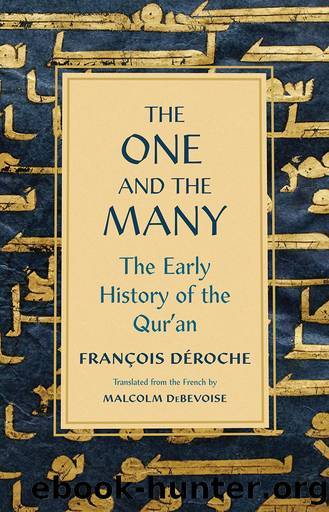The One and the Many by Francois Deroche

Author:Francois Deroche
Language: eng
Format: epub
Publisher: Yale University Press
Published: 2021-01-15T00:00:00+00:00
FIGURE 17. Q. 2:132â40. In 2:137 (line 14), the text exhibits a variant attributed to Ibn MasâÅ«d. Qurâanic manuscript Paris, BnF Arabe 331, fol. 1v (first half of the eighth century).
Tradition mentions two cases in which a disciple of Muhammad chose to preserve a variant that had been removed from the âUthmÄnic recension. The first one case exhibits a notable similarity with the manuscripts we have just looked at, namely, that the variant in question is attributed to Ibn MasâÅ«d. AbÅ« al-DardÄâ, discussing Ibn MasâÅ«dâs reading of Q. 92:1 with another Companion, is reported to have said that he too had heard it spoken by Muhammad and declared his intention to go on reciting the sura in this fashion, notwithstanding the official prejudice against it.67 The situation is a bit different in the second case, which we considered earlier, though this time it is the manuscript tradition, rather than the manner of recitation, that interests us. According to certain accounts, âÄâishaâs personal copy of the Qurâan included this version of Q. 2:238, which she claimed to have heard Muhammad pronounce: ḥÄfiáºÅ« âalÄ al-á¹£alawÄti wa-l-á¹£alÄti al-wuá¹£á¹Ä wa-á¹£alÄti al-âasri (take care to do your prayers, including the middle prayer and the afternoon prayer). Muhammadâs other wife, Ḥafá¹£ a, testified to the same effect. In both these instances one finds a practice that we have already encountered in connection with oral transmission: choice, or selection (ikhtiyÄr).68 Here, however, the rasm itself has been altered.
Like the Codex Parisino-Petropolitanus, but in a different manner, manuscripts E 20 and Arabe 331 allow us to appreciate the malleability of the Qurâanic text in the mid-eighth century. Notations in Arabe 331 indicate that it was bequeathed in perpetuity to an undesignated mosque, perhaps that of âAmr in Fusá¹Äá¹. This folio edition is unlikely to have been made for someoneâs personal use; it is far more probable that it was originally meant to be deposited in a particular place of worship, in keeping with a practice that is attested during this period, and therefore perfectly acceptable by contemporary standards, notwithstanding the textual peculiarities that Arabe 331 exhibits. The missing word was entered later, exactly when it is impossible to say. It is reasonable to suppose that what we observe in both cases came about when a copyist, seeking to satisfy either the wishes of a sponsor or those of a part of the Muslim community, occasionally preferred the text of a different version than the one he usually followed in making his transcriptionâin the event, the one that came to be considered canonical. Further exploration of the Qurâanic manuscript tradition during the seventh century and the first half of the eighth may be expected to uncover similar cases, strengthening the evidence we presently have of a quite different approach to the text than the literalism that later came to be strictly enforced.
We have now examined three manuscripts, the first of which belongs to the tradition of the âUthmÄnic rasm but displays discrepancies that represent a stage on the road
Download
This site does not store any files on its server. We only index and link to content provided by other sites. Please contact the content providers to delete copyright contents if any and email us, we'll remove relevant links or contents immediately.
| Hadith | History |
| Law | Mecca |
| Muhammed | Quran |
| Rituals & Practice | Shi'ism |
| Sufism | Sunnism |
| Theology | Women in Islam |
The History of Jihad: From Muhammad to ISIS by Spencer Robert(2564)
Nine Parts of Desire by Geraldine Brooks(2325)
The Turkish Psychedelic Explosion by Daniel Spicer(2313)
The First Muslim The Story of Muhammad by Lesley Hazleton(2217)
The Essential Rumi by Coleman Barks(1987)
1453 by Roger Crowley(1956)
The Last Mughal by William Dalrymple(1829)
Trickster Travels: A Sixteenth-Century Muslim Between Worlds by Davis Natalie Zemon(1813)
God by Aslan Reza(1610)
Muhammad: His Life Based on the Earliest Sources by Martin Lings(1605)
by Christianity & Islam(1594)
A Concise History of Sunnis and Shi'is by John McHugo(1545)
Magic and Divination in Early Islam by Emilie Savage-Smith;(1498)
No God But God by Reza Aslan(1489)
The Flight of the Intellectuals by Berman Paul(1461)
Art of Betrayal by Gordon Corera(1399)
Nothing to Envy by Barbara Demick(1383)
What the Qur'an Meant by Garry Wills(1359)
Getting Jesus Right: How Muslims Get Jesus and Islam Wrong by James A Beverley & Craig A Evans(1307)
